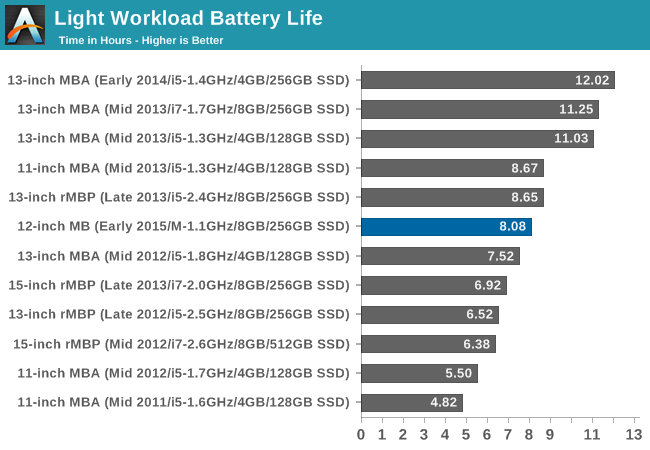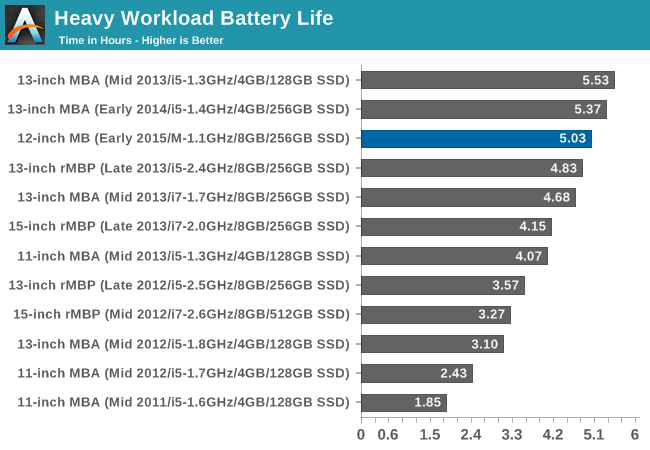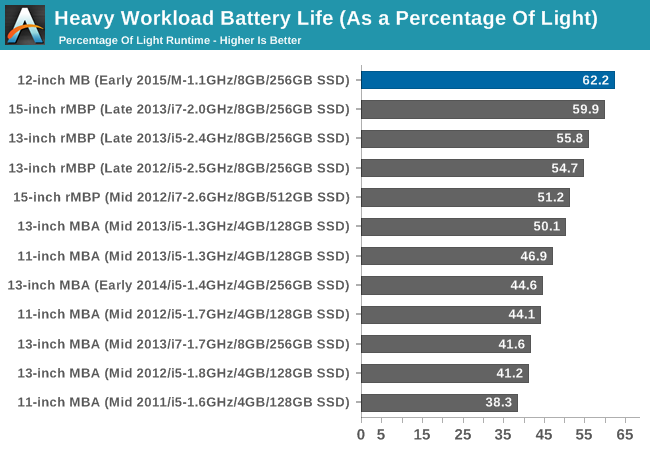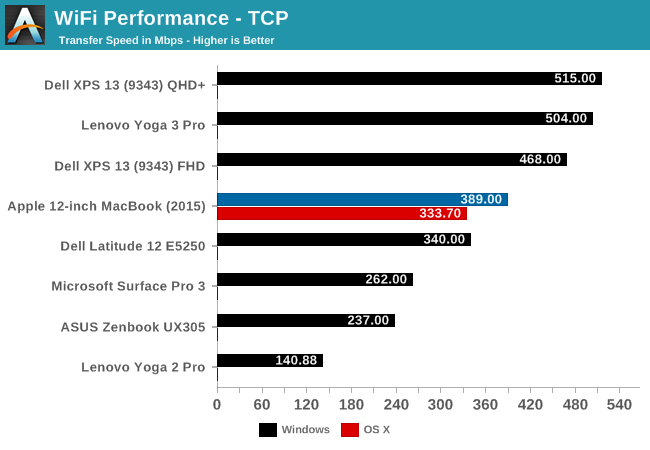The 2015 MacBook Review
by Ryan Smith on April 14, 2015 10:15 AM ESTBattery Life & WiFi Performance
Last but certainly not least in our look at the MacBook is a look at its battery life and WiFi performance.
Along with the technical considerations that have gone into making the MacBook as small as it is, I would consider the subject of battery life to be the second most interesting aspect of the MacBook’s design. For on the one hand, the CPU at the heart of this laptop is Core M, a very low power CPU specifically designed for thin & light devices, which on its own doesn’t draw all that much power. On the other hand in constructing the MacBook Apple has ditched the MacBook Air’s standard DPI TN panels for high DPI Retina IPS panels. As we’ve seen in other Apple products in the past, going Retina incurs a significant power cost, as the high DPI displays require a much stronger, much more power hungry backlight to light up the display. Apple needs only to pay this cost once, but it’s an expensive cost.
All the while Apple also has to deal with the battery capacity limits of such a small chassis. Using terraced batteries has allowed Apple to maximize the amount of volume the MacBook’s batteries occupy, however at 39.7Wh this only gets them up to roughly where the 11” MBA (38Wh) already sat. The end result is that relative to the 11” MacBook Air Apple has virtually the same battery capacity to drive a less power-hungry CPU and logic board paired with a more power-hungry display.
Officially the MacBook should be able to hit 9 hours of runtime on a light web workload, and 10 hours with video playback. This happens to be identical to what the 11” MacBook Air is rated for, and in practice would be very close to what the Haswell-based 11” Airs hit as well.
Meanwhile to test battery life, we have two workloads. Our light test is light web browsing, and our heavy test increases the number of pages loaded, adds a 1 MB/s file download, and has a movie playing. We set all displays to 200 nits.

In practice what we find is that by our testing methodologies the MacBook falls about an hour short, clocking in at 8 hours and 5 minutes. The difference in battery life most likely comes down to differences in how we test; Apple bases their estimates on 75% display brightness, whereas we test at 200 nits, which in the case of the MacBook is around 85% brightness. If we turned our brightness down to 75% I suspect our results would come very close to Apple’s, at the cost of dropping below 200 nits of brightness.
Even by our own testing standards, the MacBook’s battery life is enough to get the laptop through an entire work day (8 hours) – if only just – so while we can’t hit 9 hours at our preferred brightness Apple isn’t in too poor of a position for such a small laptop. In practice what this means is that the MacBook does just a bit worse than the 11” MacBook Air, essentially falling behind by 40 minutes of runtime. However given the fact that the MacBook is also physically smaller than the 11” Air, this is not an unexpected tradeoff.
Putting things in a bit larger perspective, thanks to Intel’s massive energy efficiency gains from Haswell in 2013, the MacBook looks very good compared to the older 2011/2012 11” MacBook Air models. From a battery life perspective the new MacBook easily exceeds those models, is physically smaller than those models, and all the while delivers performance that at worst is equivalent and at best better than those models. Put another way, Apple has been able to hold performance constant while bringing down both the size and greatly improving the battery life.
However if you want better than 8 hours on a light workload, then even the MacBook is no substitute for a larger laptop with a bigger battery. There’s only so much that can be done on 39.7Wh, and as a result the 13” MacBook Air will remain unmatched as Apple’s long-haul Ultrabook.

Meanwhile with a heavy workload the MacBook’s fortunes improve. No longer just in the middle of the pack, at 5 hours and change it’s offering runtimes close behind the 13” MacBook Airs. This shift in relative performance is not unexpected, and is closely tied to the balance between CPU power consumption and display power consumption. Compared to the light workload, the heavy workload requires that the CPU draw quite a bit more power all the while the amount of power drawn by the display is virtually unchanged. As a result the higher powered MacBook Airs see a big step up in their power requirements, while the Core M equipped MacBook sees a smaller step up.

In fact if you look at heavy workload runtime as a percentage of light workload runtime, the 2015 MacBook has the smallest drop in runtime out of all of the MacBooks. Apple’s latest laptop gets 62.2% of its light runtime under the heavy workload, compared to 50.1% for the best MacBook Air. The only thing with a similarly small decrease are the Retina MacBook Pros, whose large, Retina displays result in a similar situation.
Somewhat paradoxically then, the MacBook looks best under a heavy workload, even though its processor is relatively slow. Ultimately this is more an intellectual curiosity than anything else, but it’s a great example of how the MacBook’s component selection has resulted in a much different power consumption balance between the display and CPU than what we’ve seen on the MacBook Airs and similar Ultrabooks. If the display isn’t the single biggest power draw on the MacBook, it’s certainly going to be a close second.
WiFi Performance
Our final benchmark is a quick glance at WiFi performance. The MacBook ships with a Broadcom 2x2:2 802.11ac solution, which means that in theory it is capable of delivering up to 833Mbps.
For our WiFi benchmark we copy a large file from a Gigabit Ethernet connected SMB file server, timing how long it takes to transfer the complete file and calculating the average. All laptops are placed within a few feet of the router to maximize their achievable bandwidth and minimize interference. For the MacBook we’ve gone ahead and run this test under both Windows and OS X, to showcase any performance differences between the two OSes.

Under Windows the MacBook hits 389Mbps, about 47% of its theoretical maximum performance. Compared to other Windows laptops this is a mixed bag, with some laptops able to hit as high as 500Mbps, and others coming up much shorter. In the case of the MacBook I suspect the all-aluminum chassis is not doing it any favors. Meanwhile performance under OS X is a bit worse at 333.7Mbps, most likely due to OS X’s less extensively optimized SMB support.
While I imagine it’s impractical from a design perspective, given the fact that the MacBook only has a single USB port, I would have liked to see a 3x3:3 solution for the MacBook to allow it to achieve better WiFi performance. Even 3x3 solutions seldom keep up with GigE in the real world, but the MacBook certainly has the SSD and processing power to handle faster speeds than what we’re seeing here.










354 Comments
View All Comments
xchaotic - Monday, April 20, 2015 - link
They won't let you do that due to planned obscolesnce by both Apple and Intel. 16GB RAM and 1TB SSDs will be the max for quite some time.shompa - Friday, April 24, 2015 - link
One point about Intel/ARM. Intel Core-M 82mm2 1,3 billion transistors. Cost about 280 dollars + you have to buy Intel motherboard chips. Apple A8X is 132mm2 3 billion transistors. It cost Apple about 20 dollar to manufacture that. (on the market 130mm2 ARM SoCs cost about 50 dollars unsubsidized). When will the techpress and IT experts point this out? How can something that cost Intel 50% less than A8X cost the customer 20times more?The Macbook have an insane price but Intel is at least 400 dollar of that problem.
This is why we need to move away from X86 to ARM. (and Apple will move to ARM because they controll the OS/Hardware = they can add anything they want into the SoC. Huge parts of the A class SoCs are Apple specific stuff like Siris DSP, the visual processor, security enclave/TouchID and so on. About 30% of die area today. Imagine if Microsoft started to do custom ARMs/(or AMD X86) for their Windows. That would add value to the customer and make people buy MSFT hardware because they want to (not because they are forced to, like today with their OS)
One of the main problem is "capitalism". A good (older) company have 10-12% profit on what they sell. Simple math: 10% on a 500dollar intel is more than 10% on a 25 dollar ARM.
Intel is however a monopoly today. If I want a fast laptop: They are the only choice. But Intel is doing the same mistake as Sun, IBM, PA-RISC, PPC, DEC-Alpha, MIPS and all other fun CPUs have existed in history. (Because: let me tell you a secret: X86 have never had the fastest/best CPU in history. They had Windows + where cheap/good enough. Thats why Intel almost had no share in the server market. 2005/6 intel slashed Xeon prices to sub 300 dollar = why buy a RISC chip that is twice as fast for 4000 dollars? In under 3 years intel managed to get over 50% of server revenue. Today its about 80%. But its because Intel charges 4000 dollar for their xeons. History is repeating itself)
ixproval - Monday, April 27, 2015 - link
Anyone else notice that the article implies a comparison to the current 11" MBA (2015, Broadwell), there are no performance numbers for that model (or the 2015 13" MBA for that matter)? The latest comparisons on the majority of the performance graphs are the early 2014 13" MBA and the mid-2014 rMBP? At first I was wondering about release dates but they were announced at the same event. Did you guys just not have a 2015 11" MBA available for comparison? I apologize if I missed a reason for the omission in the article text.tipoo - Saturday, May 2, 2015 - link
So the UX305 uses a lower end cheaper Core M, but since it throttles less it ends up performing better than the Macbook...That's a bit disappointing. If they gave it a bit better cooling it would have had the better performing chip all around.HooDude - Sunday, May 3, 2015 - link
I bought one of these with the 1.1 ghz CPU. The fit and finish of the laptop is great, it's a beautiful device. However, it is terribly slow and the keyboard is awful. It lagged hard when I would try to scroll PDF files in preview, and typing on it was fatiguing to my hands and felt like I was typing on a table top instead of a keyboard. I ended up returning it because of these faults.Agrou - Tuesday, May 5, 2015 - link
Any news/details about the MVNe controller ? Does anyone knows on what it is based ? I want to run natively a linux distro on my macook air but the SSD is not seen. I want to try to load the controller's driver apple used to integrate on the ship.Remark : they also put this controller on the 11 inch model with core i7 I do have APH0128 in OSX HW informations.
Clorex - Monday, May 11, 2015 - link
Regarding the display's white point:"The goal here is 6504; the MacBook hits 6828, reflecting the fact that it’s just a bit too red and just a bit too light on blue."
I think it should be the other way round: the display should be bluish with a colour temperature of 6828 K.
EOL - Monday, May 11, 2015 - link
About the shallower keyboard: the keyboard MacBook Air (mid-2011, at least) does have a problem that the new butterfly keyboard might solve: key corners can quickly become imprinted onto the screen. This is a slightly annoying when watching videos, as the marks are quite visible, with a black background. Hopefully the new keyboard will prevent keys from damaging the screen, this time.birowsky - Tuesday, May 12, 2015 - link
can i just buy a force touch trackpad somewhere? i wanna put this beauty in my 15" rMBPAnthLC - Saturday, June 13, 2015 - link
I think it a great review and very helpful.I am planning on buying either this MacBook 12" or HP XPS 13". I do prefer Apple cause will work better together with my iPad and iPhone. Apple do make good solid devices and provide frequent updates. I need something similar in size to my iPad and light.
My concerns with the MacBook relate to performance, first gen fanless, the one USB-C port and the keyboard. While with the HP by all reports the fan can be irritatingly noisy, lack of HP fixes, updates, device driver issues and priced $100 more then the MacBook.
I primary use the IPad as my stock home computer and like a lot of people it is all I need. But I have hobby that require a PC application software. I don't have a real preference Mac or PC will do. But windows 8 is a turn off. Luckily for me the software works on both platforms.
The review has help me realise the performance should be fine to run standard PC applications. The single USB-C port was a concern because the software I plan to use requires a USB dongle.
But I haves learned there are solutions such as Infiniteusb which will actually overcome the single port problem. (http://getinfiniteusb.com) actually mean one port will probably be better.
Some people say well you have to carry the dongle, but the thing is if you have the need to plug in accessories well you will be carrying more then just the laptop whether there is one or more ports. Which to my mind makes the whole point mute. The daisy chaining of USB-C is cool too.
I like the idea of fanless. On the Internet and HP's own website user reviews suggest the HP XPS has some design fault, a noise that can be quiet annoying. I don't believe has been addressed.
In Australia the base HP XPS is about $100 more then thie base MacBook 12".
So I plan to get the MacBook 12".
I was thinking maybe the MacBook Air 13" but when you add on the upgrade to 8gb and 256gb HD equivalent of the base MacBook 12", there only $100 difference. I would rather a a Retina display. I also looked at the old MacBook Pro 13" but same price and I prefer the smaller footprint of the MacBook 12".
So I thought it may be interesting to post why I decide to buy the MacBook over the HP.
For me and a lot of people we don't want a high powered laptop with all the bells and whistles. Apple have squarely filled the gap for users like me who primarily use a iPad but have a need for a portable PC.
I did find it telling that I could buy a 15" laptop from Dell cheaper then their own HP XPS and 15" had better specs. It does suggest this is what people are buying and wanting. I mean a couple of years ago bigger laptops were the expensive ones.
Lastly there is a premium in price for these small laptops which is to say a opportunity for other manufacturers to come along and deliver similar device at a cheaper price point.